What is the CBP 6059B form?
The CBP 6059B form is a Customs and Border Protection document used for travelers entering the United States. It helps collect essential information about travelers and their items. This form assists U.S. authorities in maintaining safety and security at the border.
Who needs to fill out the CBP 6059B form?
All travelers entering the United States are required to complete the CBP 6059B form. This includes U.S. citizens, permanent residents, and foreign visitors. The form needs to be filled out prior to or upon arrival in the U.S.
How do I obtain a CBP 6059B form?
You can obtain a CBP 6059B form from a variety of sources. Customs officers usually distribute the form during flights or upon arrival at ports of entry. Alternatively, you can download a copy from the official U.S. Customs and Border Protection website, if available.
What information is required on the CBP 6059B form?
The CBP 6059B form requires basic personal information, such as your name, address, date of birth, and citizenship. You'll also need to declare items you are bringing into the U.S., including goods, currency, and food items.
Is there a deadline for submitting the CBP 6059B form?
The deadline for submitting the CBP 6059B form is typically at the time of your entry into the U.S. You must present it to a Customs officer when requested. Failure to provide complete and accurate information can lead to delays or even penalties.
Can I submit the CBP 6059B form electronically?
As of now, the CBP 6059B form is primarily a paper form that you submit upon entry. Some information may be collected electronically through other means, like the Electronic System for Travel Authorization (ESTA) for specific travelers, but the CBP 6059B itself must be submitted physically at the border.
What happens if I forget to fill out the CBP 6059B form?
If you forget to complete the CBP 6059B form, it may lead to complications at the border. Customs officers may ask you to fill it out before you can proceed. Delays can occur if you haven’t declared necessary items, potentially resulting in further questioning or inspections.
Where can I get help if I have questions about the CBP 6059B form?
If you have questions about the CBP 6059B form, you can reach out to the U.S. Customs and Border Protection directly. Their website offers various resources, or you can contact customer service for specific inquiries. Additionally, airport personnel can assist you if you're filling it out upon arrival.



 (c) State
(c) State 



 No
No
